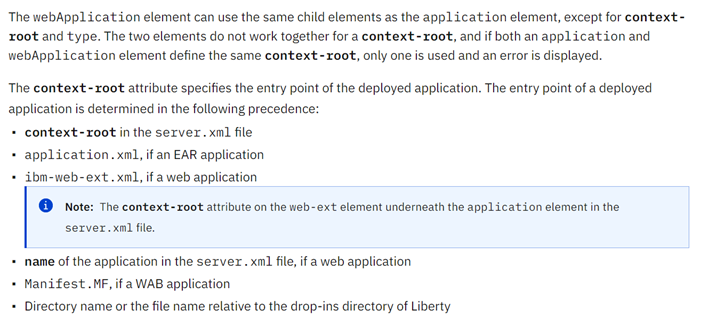Detect the monitored app name
How to find the name of your application for referencing in the IAST configuration file.
When using the monitoredApp field in the configuration file to
define which of the web applications on the server will be monitored by IAST, use
these guidelines to find the application names.
Note: When an
application name is derived from a filename that includes a crosshatch (#), ASoC replaces this symbol with a forward slash (/). For
example, if the Tomcat file my#demo.war is deployed (see
below), the application name will be my/demo
Tomcat
- If using the auto-deploy feature in the webapps directory (recommended), the
application name is the filename without the
WARextension. The name for demo.war is demo. - If using the
XMLfile underCATALINA_BASE/conf/[engine name]/[host name], the application name is the filename without theXMLextension. The name for demo.xml is demo. - If using context elements statically in a server.xml file,
the application name is the path attribute value in the context element.
Example:
 In this example the application name is
mydemo/version1
In this example the application name is
mydemo/version1
Websphere
- If using default context settings, the application name is derived from the
WARfilename preceded by/. The name for demo.war is /demo. - If using an
EARfile, the context path resides within it, in /WEB-INF/lib/application.xml. This file contains anXMLelement called context-root whose value is the application name. - If using a
WARfile, the context path reside within it, in /WEB-INF/ibm-web-ext.xml. This file contains anXMLelement called context-root whose value is the application name.
Websphere-Liberty
The application name is the value of the content root, determined by the following
rules:

Open-Liberty
- If context root is defined in server.xml for the application, then the value of the contextRoot attribute of the webApplication element is the application name.
- If not, then the application name is the name of the deployed application file, without its extension. The name for demo.war is demo.
Weblogic
- If context root is defined in the descriptor file in either META-INF/application.xml or in WEB-INF/weblogic.xml, the application name is the value of context-root element in those files. If the values are different, the one in META-INF/application.xml takes precedence.
- If not, then the application name is the name of the deployed application file, without its extension. The name for demo.war is demo.
Wildfly
- If context root is defined in the descriptor file in either META-INF/application.xml or in WEB-INF/ jboss-web.xml, the application name is the value of context-root element in those files. If the values are different, the one in META-INF/application.xml takes precedence.
- If not, then the application name is the name of the deployed application file, without its extension. The name for demo.war is demo.